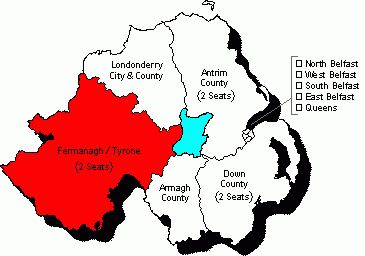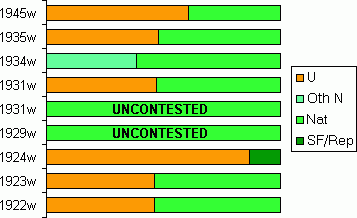

 |

|
| |
| |

|

|
| Map and diagram by Conal Kelly | |
This two seat constituency covered the largely rural south-western quarter of Northern Ireland, including all of counties Fermanagh and Tyrone. Established under the terms of the Government of Ireland Act 1920, the constituency replaced the single seat constituencies of North Fermanagh, South Fermanagh, North-West Tyrone, North-East Tyrone, and South Tyrone. Unlike single seat constituencies, Fermanagh and Tyrone used the plurality-at-large (Block) voting system, where each voter selected up to two candidates, and the two candidates receiving the largest number of votes were the winners. Between 1922 and 1949 the constituency was represented by eight different MPs (6 Nationalists, 2 Unionists). The general election of 1929 and the single seat by-election of 1931 went uncontested. The declared winners in both cases were the Nationalist nominees. The constituency had the highest turn-out across Northern Ireland in the 1922, 1923, 1931, 1935, and 1945 general elections.
See also election results for Fermanagh & South Tyrone 1950-1970, 1973-1982, 1983-1992 and 1993-2007.
| U | Ind N | Nat | SF | |
| 1945w | 45.6% | 54.4% | ||
| 1935w | 47.7% | 52.3% | ||
| 1934w-b | 38.6% | 61.4% | ||
| 1931w | 47.1% | 52.9% | ||
| 1931w-b | * | |||
| 1929w | * | |||
| 1924w | 86.9% | 13.1% | ||
| 1923w | 46.2% | 53.8% | ||
| 1923w | 46.2% | 53.8% |
* The only candidates nominated for the 1929 General Election were Nationalists Joseph Devlin and Thomas Harbison. The only candidate nominated for the 1931 By-Election was Nationalist Cahir Healy. In each instance the nominated candidates were therefore duly elected without a contest.
Nationalist majority: 8,752; electorate: 114,977; votes cast: 88.4% (Note: each voter selects up to two candidates)
Once again the
Nationalist Party nominated Cunningham and Mulvey to defend the two
Fermanagh and Tyrone seats. Their opposition would come from two new
Unionist Party candidates; Thomas Lyons and Noreen Cooper. Despite
the ten year gap since the last election, the result was largely the
same as 1935 and the two Nationalist were returned once more. One
might be tempted to say that the integrity of their quarrel is
one of the few institutions that had been unaltered by the
intervening war. Fermanagh and Tyrone did retain its mantle for
the highest turn-out of the election with 88.4%.
Noreen Cooper was the first woman to contest a Westminster seat
since the founding of Northern Ireland. Thomas Lyons had been
previously elected to the Northern Ireland House of Commons for
North Tyrone in a by-election in August 1943. He would hold the
seat until 1969. He would go on to become Chairman of Ways and
Means committee and Deputy Speaker of the House of Commons between
1955 and 1969.
Nationalist majority: 3,978; electorate: 118,322; votes cast: 82.0% (Note: each voter selects up to two candidates)
Neither of the
Nationalist Party incumbents stood in the 1935 Westminster elections.
In their place, the Nationalist Party selected Patrick Cunningham and
Anthony Mulvey. The Unionist Party also opted for new candidates,
fielding Roland Deane and Capt. John Blakiston-Houston. The Unionists
very slightly improved on their 1931 performance but not enough to
win the seats. Cunningham and Mulvey were returned with over 52% of
the vote. At 82%, Fermanagh and Tyrone once more had the highest
turn-out of the election.
Blakiston-Houston would later unsuccessfully contest the
the 1945 general election in Down.
His grandfather had been the MP for North Down between 1898 and 1900 and his
uncle sat for Belfast Dock in the Northern Ireland House of Commons between
1929 and 1933.
Nationalist majority: 10,701; electorate: 118,884; votes cast: 39.4%
Following the death
of Joe Devlin in January 1934, a by-election was held the following June.
The Nationalist Party nominated the Stormont MP for East Tyrone, Joseph
Stewart as their candidate. While the Unionist Party chose not to contest
the election, opposition came in the form of Independent Nationalist
candidate, Dominick McCrossan. Despite the low turn-out (39.4%), Stewart
was successfully returned with 61% of the vote and a majority in excess of
10,000.
Stewart had been previously elected to the Northern Ireland House of Commons
at the 1929 general election for East Tyrone, a seat he held until his death
in 1964.
Nationalist majority: 5,296; electorate: 116,965; votes cast: 81.7% (Note: each voter selects up to two candidates)
The 1931 Westminster
elections would give Fermanagh and Tyrone its first actual electoral contest
since 1924. The incumbents, Devlin and Healy, would once again represent the
Nationalist Party, while the Unionists put forward Hugh Irwin and Capt. Ynyr
Burges. In what was the closest result of the election in Northern Ireland,
Devlin and Healy were victorious, gathering some 53% of the vote.
Fermanagh and Tyrone was one of only three constituencies that were contested
during the 1931 Westminster elections. At 81.7%, Fermanagh and Tyrone had the
highest turn-out of the election.
Unopposed Nationalist Candidate.
Following the death
of Harbison in November 1930, a by-election was called for Fermanagh and
Tyrone the following March. Cahir Healy, who had been the MP between
1922-1924, was again on the ticket for the Nationalist Party. As the sole
candidate nominated, Healy was returned upopposed.
Healy had been previously elected to the Northern Ireland House of Commons
for Fermanagh and Tyrone (8 seats) between 1925 and 1929 and later for
South Fermanagh between 1929 and 1965.
Unopposed Nationalist Candidates.
Following Sinn Fein's
poor performance in 1924, they opted not to contest the 1929 election and
the Nationalist Party had a free hand in Fermanagh and Tyrone once more.
Harbison, who had been the MP between 1922-1924, was again on the ticket,
as was Nationalist Party leader, Joe Devlin. Much to the surprise of many,
the Unionist Party opted not to contest the constituency and so Harbison
and Devlin were retunred unopposed.
Devlin had a lenghty electoral career. He had previously been elected as
MP for Kilkenny North (1902–1906), West Belfast (1906–1918), and Belfast
Falls (1918–1922). He was also elected to the Northern Ireland House of Commons
for West Belfast (1921–1929) and later Belfast Central (1929–1934).
Unionist majority: 37,899; electorate: 97,044; votes cast: 53.0% (Note: each voter selects up to two candidates)
This incumbents
Harbison and Healy did not contest the 1924 election, instead they
yielded the field to Sinn Fein. Fermanagh and Tyrone was one of seven
constituencies being contested by Sinn Fein in the 1924 election. However,
the result clearly demonstrated the lack of support for the party and
the Unionist candidates were returned with a landslide victory of almost
87% of the vote.
Their victories in Fermanagh and Tyrone, gave the Unionist Party a clean
sweep of all thirteen MPs for Northern Ireland. This was a feat that they
would not repeat until the 1959
election. Pringle stood unsuccessfully in Larne for the 1929 Northern Ireland general
election, as a Local Option temperance candidate.
Nationalist majority: 5,935; electorate: 96,497; votes cast: 84.5% (Note: each voter selects up to two candidates)
The field for the 1923 election was almost identical to the year previous. The incumbents, Harbison and Healy, were defending their seats for the Nationalist Party. On the Unionist side, while Pringle returned for a second challenge, his running mate Allen was replaced by Charles Falls. The result, however, was almost identical to that of 1922 and Harbison and Healy returned once more. At 84.5%, Fermanagh and Tyrone had the highest turn-out of the election by a considerable margin.
Nationalist majority: 6,177; electorate: 97,904; votes cast: 85.4% (Note: each voter selects up to two candidates)
This was the first
election in the new two-seat Fermanagh and Tyrone constituency. The new
constituency replaced the single seat constituencies of North Fermanagh,
South Fermanagh, North-West Tyrone, North-East Tyrone, and South Tyrone.
The Nationalist and Unionist parties both put forward two candidates.
Representing the Nationalists was Thomas Harbison, who had been elected
for North East Tyrone in the 1918 election and
Cahir Healy, an interned journalist and member of Sinn Fein. Representing
the Unionists was James Pringle and William Allen. Given the results
elsewhere, this was a relatively close contest but the Nationalist candidates
were returned with a combined 53.8% of the vote. This was one of just
two electoral contests across Norther Ireland in 1922, the other being Londonderry.
Fermanagh and Tyrone had the higher turn-out.
Harbison had been previously elected in an East Tyrone by-election in
1918 as an Irish Parliamentary Party candidate.
He was also elected to the Northern Ireland House of Commons for Fermanagh
and Tyrone (8 seats) between 1921 and 1929. Allen would go on to successfully
contest the West Belfast constituency for the
Unionists in the 1929 Westminster elections. In 1931 he would defect from the
Unionist Party and join Sir Oswald Mosley's facist New Party. He did not
conest the 1931 election.
See also:
Results from 1922 to 1949 for each seat: East Belfast | North Belfast | South Belfast | West Belfast | Antrim | Armagh | Down | Fermanagh and Tyrone | Londonderry | Queens University
Other sites based at ARK: ORB (Online Research Bank) | CAIN (Conflict Archive on the INternet) | Northern Ireland Life and Times Survey
Your comments, please! Send an email to me at nicholas.whyte@gmail.com.
Conal Kelly, 10 October 2007.
|
Disclaimer:©
Nicholas Whyte 1998-2004 Last Updated on Wednesday, 12-Jan-2005 12:12
|